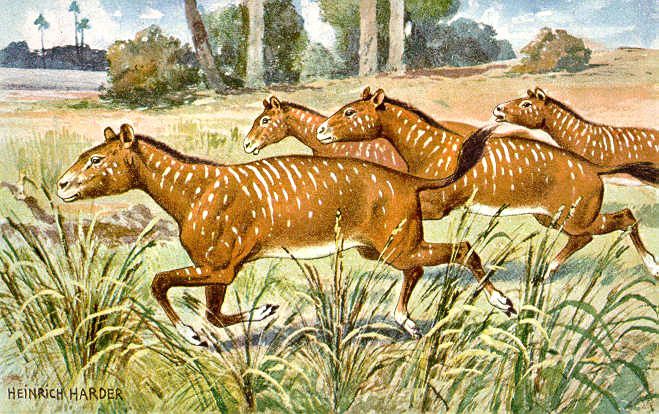
General Information
The linking transitional link between primitive horses and their present-day forms is the extinct Mesohippus. This species inhabited the modern United States during the Oligocene period. They were adapted to live in wide-open spaces and were extremely fast, though they lacked hooves. Their diet was herbivorous, eating tall grasses and flowers, which affected the structure of the Mesohippus’ dental apparatus. The animals lived according to the herd principle, and if one of the parents was lost, the duties of caring for the foal were passed on to the other adults.
Skull structure
Mesohippus had brittle teeth devoid of covering cementum tissue, which was due to their herbivorous eating style. The lower jaw of Mesohippus had a thickening in the area of attachment to the upper jaw, and the teeth did not start directly at the outer border of the jaw but were slightly recessed inside. The eye regions are rounded and directed to the sides; there was a nasal outgrowth above nostril openings. The frontal bone was flattened and rounded, apparently for the purpose of protection against enemies. The brain cavity of the skull was enlarged compared to the ancestors, so the brain of Mesohippus resembles the brain structure of modern horses.
Structure of the postcranial skeleton
The body size of Mesohippus was comparably more diminutive than that of modern horses: it reached a height of up to half a meter and resembled a modern wolf instead. The limb system was developed and adapted to move quickly on soft ground: they had no hooves, and each of the legs ended with three toes without claws, the middle of which was comparably larger than the others. This toe bore all the load during the rapid movement of Mesohippus when fleeing from predators. Mesohippus had a long neck and a single curve of the spine at the end of the thoracic region. The hind limbs were more developed and consisted of a femur, tibia, and a long foot, only the end of which touched the ground. The pelvic bones were markedly set back. The forelimbs had an extended forearm and a short shoulder.
Compared to the forelimbs of ancestral forms, the curves of the forearm and shoulder were less prominent, and the boundary between the wrist and forearm was almost invisible. The forelimbs had scapulae in the area of attachment of the forelimbs to the spine. The body ended with a long mobile tail.